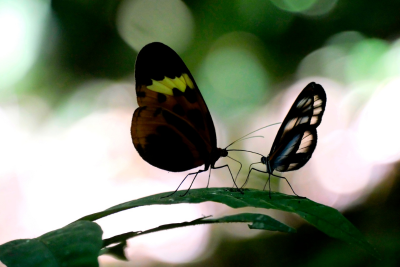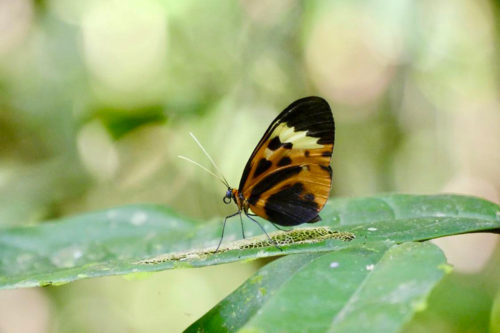
Two ithomiine butterflies (left: Hypothyris anastasia, right: Hypoleria sarepta) at Yasuni National Park, Ecuador

Image of Hypothyris anastasia at Yasuni National Park, Ecuador
Butterflies that independently evolved the same wing patterns have also evolved similar eyes and brains which are fine-tuned for vision in the shifting light of tropical rainforests, according to new research led by the University of Bristol published in PNAS this week.
Researchers spent two-and-a-half months in the depths of the Amazon rainforest, in one of the most biodiverse regions on earth – Yasuni National Park in Ecuador – measuring how light varies across the rainforest and linking this to where different species of clearwing butterflies live.
The scientists, led by Dr Benito Wainwright, wanted to investigate whether differences in light under the canopy of the rainforest could have impacted the way the butterflies' eyes and brains evolved.
The clearwing butterflies are also famous for their mimicry, with multiple species independently evolving the same bold wing patterns to warn predators that they are toxic. Dr Wainwright describes this as a 'mutualism', where both parties benefit.
The research team hoped to gain insight into the consequences this mimicry has on how the clearwing butterfly's senses evolved.
Dr Wainwright said: "We discovered that distantly related butterfly species living in the same pockets of rainforest light have evolved remarkably similar visual systems – both their eyes and their brains. Not only that, butterflies that mimic each other's warning colours tend to live in the same lighting environments, likely enhancing their shared warning signal to predators.
"This shared lifestyle has a powerful knock-on effect - we found that it also shapes how their senses evolve. In other words, species that look alike to scare predators also share similar eyes and brains, and likely see the world in similar ways. This is an astounding example of how mutualisms between species can have a profound impact on steering the course of evolution."
The research uses the example of tropical butterflies to provide insight into how tropical rainforest communities come together, and how these relationships shape the way animals see the world around them.
By improving our understanding of the factors driving biological diversity, the team hope it will enable better protection of these habitats and predict how they might cope with new environmental challenges.
Dr Wainwright added: "We are really interested in how changes in the eye and brain match up with changes at the genetic level, and how all these shifts influence the behaviour of these butterflies in the wild. Connecting these dots, we can build a more complete picture of how subtle environmental changes can shape the evolution of animal senses."
To see a video created by Dr Wainwright about this research, please click here: https://youtu.be/6jNxgvK0kU0
Paper
'Mutualisms within light microhabitats are associated with sensory convergence in a mimetic butterfly community' by Benito Wainwright, Theodora Loupasaki, Francisco Ramirez and Stephen Montgomery






